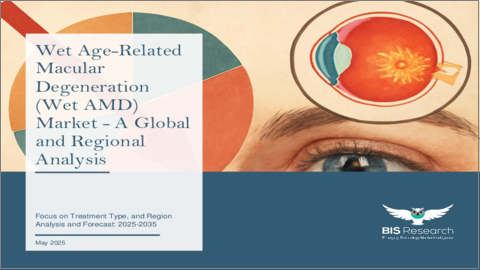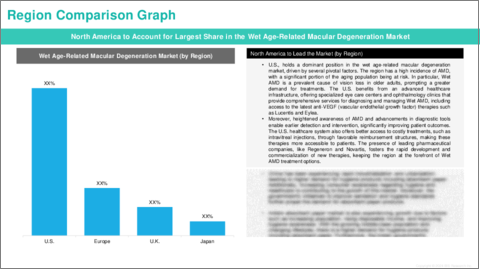|
|
市場調査レポート
商品コード
1734251
滲出型加齢黄斑変性 (滲出型AMD) の世界市場:治療タイプ・地域別の分析・予測 (2025~2035年)Wet Age-Related Macular Degeneration (Wet AMD) Market - A Global and Regional Analysis: Focus on Treatment Type, and Region - Analysis and Forecast, 2025-2035 |
||||||
カスタマイズ可能
|
|||||||
| 滲出型加齢黄斑変性 (滲出型AMD) の世界市場:治療タイプ・地域別の分析・予測 (2025~2035年) |
|
出版日: 2025年05月28日
発行: BIS Research
ページ情報: 英文 100 Pages
納期: 1~5営業日
|
全表示
- 概要
- 図表
- 目次
世界の滲出型加齢黄斑変性の市場は、高齢者人口の増加、この疾患に対する認知の向上、治療法の進歩により、堅調な成長を遂げています。
滲出型加齢黄斑変性の主な治療アプローチには、抗VEGF (血管内皮増殖因子) 療法、光線力学療法 (PDT)、レーザー手術が含まれますが、抗VEGF薬はその疾患進行を抑制または遅延させる効果が証明されていることから、市場シェアの最大部分を占めています
同市場の最も重要な成長要因は、世界的な高齢化です。人々の寿命が延びるにつれ、滲出型加齢黄斑変性を含む加齢に関連する眼疾患の発症率も増加します。加齢黄斑変性は、特に65歳以上の人々に多く見られますが、先進国を中心に高齢者人口が増加しているため、滲出型加齢黄斑変性の患者数も増加しています。国連は、80歳以上の人口が2019年の1億4,300万人から、2050年には4億2,600万人へと増加すると予測しており、これにより滲出型加齢黄斑変性の治療を必要とする患者層も拡大していくと見込まれます。
光干渉断層計 (OCT) や眼底写真といった技術の進歩により、滲出型加齢黄斑変性を初期段階で検出する能力が大きく向上しています。早期診断が可能となることで、タイムリーな介入が行われ、疾患の進行を遅らせ、患者の転帰を改善することができます。こうした先進的な診断機器のクリニックや病院での採用が進むことで、抗VEGF療法やその他の治療が必要な患者を特定できるようになり、市場の成長を後押ししています。
滲出型加齢黄斑変性市場が進化を続ける中、長時間作用型の治療薬の開発、AIによる早期検出などの先進的な診断技術の導入、個別化医療への関心の高まりといった新たな動向が、今後の市場の方向性を形成する見通しです。特に医療インフラが整っていない地域において、より手頃で効果的かつアクセスしやすい治療法に対する需要が高まっており、市場拡大に向けた大きな機会を生み出すことが期待されています。
当レポートでは、世界の滲出型加齢黄斑変性の市場を調査し、主要動向、市場影響因子の分析、法規制環境、臨床試験の動向、市場規模の推移・予測、各種区分・地域/主要国別の詳細分析、競合情勢、主要企業のプロファイルなどをまとめています。
目次
エグゼクティブサマリー
第1章 世界の滲出型加齢黄斑変性市場:業界の展望
- 市場動向
- 規制の枠組み
- 疫学
- 臨床試験分析
- 市場力学
- 影響分析
- 市場促進要因
- 市場の課題
- 市場機会
第2章 世界の滲出型加齢黄斑変性市場:治療タイプ別
- 抗VEGF療法
- 遺伝子治療
- その他
第3章 世界の滲出型加齢黄斑変性市場:地域別
- 北米
- 欧州
- アジア太平洋
- 主な調査結果
- 市場力学
- 市場規模・予測
第4章 世界の滲出型加齢黄斑変性市場:競合情勢・企業プロファイル
- 各社の主要戦略と展開
- 資金調達活動
- M&A
- 規制当局の承認
- 提携・協力・事業拡大
- 企業プロファイル
- Regeneron Pharmaceuticals Inc
- Ophthotech Corporation
- Adverum Biotechnologies Inc
- Apellis Pharmeceuticals Inc
- Kubota Pharmaceutical Holdings Co. Ltd.
- Pfizer Inc.
- Novartis AG
第5章 調査手法
List of Figures
- Figure: Global Wet Age-Related Macular Degeneration Market, Dynamics Impact Analysis
- Figure: Epidemiology of Wet Age-Related Macular Degeneration
- Figure: Global Wet Age-Related Macular Degeneration Market Coverage
- Figure: Global Wet Age-Related Macular Degeneration Market Key Trends, Impact Analysis, 2023-2035
- Figure: Global Wet Age-Related Macular Degeneration Market, Competitive Landscape, January 2022-April 2025
List of Tables
- Table: Global Wet Age-Related Macular Degeneration Market, Clinical Trial Analysis,
- Table: Global Wet Age-Related Macular Degeneration Market Dynamics, Impact Analysis
- Table: Global Wet Age-Related Macular Degeneration Market (by Treatmet Type), $Million, 2023-2035
- Table: Global Wet Age-Related Macular Degeneration Market (by Region), $Million, 2023-2035
Global Wet Age-Related Macular Degeneration Market, Analysis and Forecast: 2025-2035
Wet age-related macular degeneration is a progressive eye disease that is a leading cause of vision loss in individuals over the age of 50. It occurs when abnormal blood vessels grow under the retina, leaking fluid and causing damage to the macula, which is responsible for central vision. The condition severely affects the ability to read, recognize faces, and perform other tasks that require sharp vision. Wet age-related macular degeneration represents a major challenge for healthcare systems globally, as it significantly impacts the quality of life and imposes a high burden on individuals and economies.
The global wet age-related macular degeneration market is experiencing robust growth, driven by an aging population, increasing awareness about the condition, and advancements in treatment options. Key therapeutic approaches for wet age-related macular degeneration include anti-VEGF (vascular endothelial growth factor) therapies, photodynamic therapy, and laser surgeries, with the anti-VEGF drugs holding the largest market share due to their proven efficacy in halting or slowing disease progression. Furthermore, emerging treatments, including cell and gene therapy and stem cell therapy, are gaining attention as potential future solutions.
The most significant driver for the wet age-related macular degeneration market is the aging global population. As people live longer, the incidence of age-related eye conditions, including wet age-related macular degeneration, increases. Age-related macular degeneration is most common in individuals aged 65 and older, and as the world's elderly population continues to grow, particularly in developed nations, the number of wet age-related macular degeneration cases rises. The UN projects that the number of people aged 80 and older will increase from 143 million in 2019 to 426 million by 2050, leading to a larger patient pool for wet age-related macular degeneration treatments.
Technologies such as optical coherence tomography (OCT) and fundus photography have greatly enhanced the ability to detect wet age-related macular degeneration at an early stage. Early diagnosis allows for timely intervention, helping to slow disease progression and improve patient outcomes. The adoption of advanced diagnostic tools in clinics and hospitals is driving market growth by enabling healthcare providers to identify patients who would benefit from anti-VEGF therapies or other treatments.
The wet age-related macular degeneration market is indeed growing due to increasing awareness, technological advances in treatments, and an aging global population. However, the combination of high treatment costs, side effects, limited access to care, and the ongoing challenge of offering curative treatments are significant factors restricting the market's potential. Companies in the sector need to focus on reducing the cost of treatment, improving patient adherence, and advancing research to provide long-term and potentially curative therapies for Wet AMD. Addressing these challenges will be key to unlocking the market's full growth potential.
Some of the major players in the global wet age-related macular degeneration market, such as Regeneron Pharmaceuticals Inc., Kubota Pharmaceutical Holdings Co. Ltd, and Adverum Biotechnologies Inc., are continuously innovating to improve the effectiveness and comfort of wet age-related macular degeneration products. These companies are investing heavily in research and development to introduce new, technologically advanced solutions that cater to market growth. With a strong emphasis on user-friendly and environmentally sustainable products, these companies are shaping the future of wet age-related macular degeneration while enhancing their market positions globally.
The competitive landscape of the global wet age-related macular degeneration market is diverse, with numerous players across different regions offering a wide range of products. As consumer preferences shift towards more discreet, comfortable, and affordable solutions, the wet age-related macular degeneration market will continue to evolve, fostering new opportunities for both established and emerging companies.
Market Segmentation:
Segmentation 1: by Treatment Type
- Anti-VEGF Therapies
- Gene Therapy
- Others
Segmentation 2: by Region
- North America
- Europe
- Asia-Pacific
As the wet age-related macular degeneration market continues to evolve, emerging trends such as the development of long-acting therapies, the integration of advanced diagnostic technologies like artificial intelligence (AI) for early detection, and the increasing focus on personalized medicine will shape its future trajectory. The growing demand for more affordable, effective, and accessible wet age-related macular degeneration treatments, particularly in underserved regions with limited healthcare infrastructure, will create significant opportunities for market expansion.
In conclusion, the global wet age-related macular degeneration market is on track for continued growth, driven by the aging population, increasing awareness of wet age-related macular degeneration, and the development of more effective and comfortable solutions. The ongoing advancements in product technology and the expansion of care options will continue to shape the market's future. As demand for wet age-related macular degeneration solutions rises, both global and regional players will play a key role in meeting the needs of individuals and healthcare systems alike, improving the quality of life for people living with incontinence.
Table of Contents
Executive Summary
Scope and Definition
Market/Product Definition
Inclusion and Exclusion
Key Questions Answered
Analysis and Forecast Note
1. Global Wet Age-Related Macular Degeneration Market: Industry Outlook
- 1.1 Introduction
- 1.2 Market Trends
- 1.3 Regulatory Framework
- 1.4 Epidemiology of Wet Age-Related Macular Degeneration
- 1.5 Clinical Trial Analysis
- 1.6 Market Dynamics
- 1.6.1 Impact Analysis
- 1.6.2 Market Drivers
- 1.6.3 Market Challenges
- 1.6.4 Market Opportunities
2. Global Wet Age-Related Macular Degeneration Market, by Treatment Type, $Million, 2023-2035
- 2.1 Anti-VEGF Therapies
- 2.2 Gene Therapy
- 2.3 Others
3. Global Wet Age-Related Macular Degeneration Market, by Region, $Million, 2023-2035
- 3.1 North America
- 3.1.1 Key Findings
- 3.1.2 Market Dynamics
- 3.1.3 Market Sizing and Forecast
- 3.1.3.1 North America Wet Age-Related Macular Degeneration Market, by Country
- 3.1.3.1.1 U.S.
- 3.1.3.1 North America Wet Age-Related Macular Degeneration Market, by Country
- 3.2 Europe
- 3.2.1 Key Findings
- 3.2.2 Market Dynamics
- 3.2.3 Market Sizing and Forecast
- 3.2.3.1 Europe Wet Age-Related Macular Degeneration Market, by Country
- 3.2.3.1.1 Germany
- 3.2.3.1.2 U.K.
- 3.2.3.1.3 France
- 3.2.3.1.4 Italy
- 3.2.3.1.5 Spain
- 3.2.3.1 Europe Wet Age-Related Macular Degeneration Market, by Country
- 3.3 Asia Pacific
- 3.3.1 Key Findings
- 3.3.2 Market Dynamics
- 3.3.3 Market Sizing and Forecast
- 3.3.3.1 Asia Pacific Wet Age-Related Macular Degeneration Market, by Country
- 3.3.3.1.1 Japan
- 3.3.3.1 Asia Pacific Wet Age-Related Macular Degeneration Market, by Country
4. Global Wet Age-Related Macular Degeneration Market: Competitive Landscape and Company Profiles
- 4.1 Key Strategies and Developments by Company
- 4.1.1 Funding Activities
- 4.1.2 Mergers and Acquisitions
- 4.1.3 Regulatory Approvals
- 4.1.4 Partnerships, Collaborations and Business Expansions
- 4.2 Company Profiles
- 4.2.1 Regeneron Pharmaceuticals Inc
- 4.2.1.1 Overview
- 4.2.1.2 Top Products / Product Portfolio
- 4.2.1.3 Target Customers/End-Users
- 4.2.1.4 Key Personnel
- 4.2.1.5 Analyst View
- 4.2.2 Ophthotech Corporation
- 4.2.2.1 Overview
- 4.2.2.2 Top Products / Product Portfolio
- 4.2.2.3 Target Customers/End-Users
- 4.2.2.4 Key Personnel
- 4.2.2.5 Analyst View
- 4.2.3 Adverum Biotechnologies Inc
- 4.2.3.1 Overview
- 4.2.3.2 Top Products / Product Portfolio
- 4.2.3.3 Target Customers/End-Users
- 4.2.3.4 Key Personnel
- 4.2.3.5 Analyst View
- 4.2.4 Apellis Pharmeceuticals Inc
- 4.2.4.1 Overview
- 4.2.4.2 Top Products / Product Portfolio
- 4.2.4.3 Target Customers/End-Users
- 4.2.4.4 Key Personnel
- 4.2.4.5 Analyst View
- 4.2.5 Kubota Pharmaceutical Holdings Co. Ltd.
- 4.2.5.1 Overview
- 4.2.5.2 Top Products / Product Portfolio
- 4.2.5.3 Target Customers/End-Users
- 4.2.5.4 Key Personnel
- 4.2.5.5 Analyst View
- 4.2.6 Pfizer Inc.
- 4.2.6.1 Overview
- 4.2.6.2 Top Products / Product Portfolio
- 4.2.6.3 Target Customers/End-Users
- 4.2.6.4 Key Personnel
- 4.2.6.5 Analyst View
- 4.2.7 Novartis AG
- 4.2.7.1 Overview
- 4.2.7.2 Top Products / Product Portfolio
- 4.2.7.3 Target Customers/End-Users
- 4.2.7.4 Key Personnel
- 4.2.7.5 Analyst View
- 4.2.1 Regeneron Pharmaceuticals Inc





